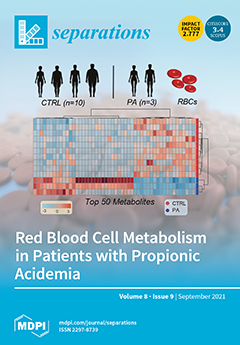In this study, supercritical carbon dioxide (scCO
2) extractions of cannabinoids were conducted at four different densities (231, 590, 818, and 911 kg/m
3) using ethanol (5%
w/v) as a co-solvent. The chemical profiles of these cannabinoids were analysed via
[...] Read more.
In this study, supercritical carbon dioxide (scCO
2) extractions of cannabinoids were conducted at four different densities (231, 590, 818, and 911 kg/m
3) using ethanol (5%
w/v) as a co-solvent. The chemical profiles of these cannabinoids were analysed via reverse-phase high-performance liquid chromatography (RP-HPLC). It was determined that scCO
2, at low density (231 kg/m
3), produced an extract yield of 6.1%
w/v. At high scCO
2 density (~818 kg/m
3), the yield was 16.1%
w/v. More specifically, the amounts of tetrahydrocannabinol (THC) and cannabidiol (CBD) in the scCO
2 extract at 818 kg/m
3 were 10.8 and 15.6%
w/v, respectively. It was also found that the use of 5%
w/v ethanol increased scCO
2 extract yields at both low and high densities (7.6%
w/v and 18.2%
w/v, respectively). Additionally, the use of co-solvent increased this yield further under both low- and high-density conditions, to 13.7 and 19.1%
w/v, respectively. Interestingly, higher scCO
2 density (911 kg/m
3) with and without ethanol did not improve the scCO
2 extract yield or the amount of cannabinoids. Although this study provides new insights into the correlation between scCO
2 density and ethanol co-extraction of CBD and THC, more studies are needed to determine how different scCO
2 densities and co-solvents influence the extraction of cannabinoids.
Full article





